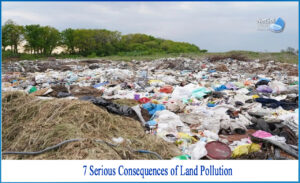Introduction
The destruction of Earth’s land surfaces as a result of human activity and the improper use of land resources is referred to as land pollution, also known as soil pollution or land degradation. The sustainability of our world, human well-being, and the health of our ecosystems are all negatively impacted by this expanding global concern. This blog attempts to highlight the critical need for group action while shedding light on the origins, effects, and solutions to land contamination.

World Environment Day: A Call to Action for a Sustainable Future
Causes of Land Pollution
inappropriate Waste Disposal: Land contamination is a result of inappropriate domestic waste disposal, which includes plastics, electronics, and organic materials. Poorly managed landfills can cause soil degradation and groundwater contamination.
Agricultural Practises: Overusing chemical fertilisers, insecticides, and herbicides causes soil erosion, nutrient loss, and contamination of the environment. Deforestation and intensive farming methods also contribute to the degradation of soil and disappearance of fertile land.
Mining: Mining activities remove rich minerals from the Earth, but also frequently cause the discharge of hazardous compounds into the soil, such as heavy metals and acids, harming the condition of the land over the long run.
Rapid urbanisation and infrastructure expansion lead to the deforestation, soil compaction, and sealing of land surfaces with concrete and asphalt, all of which contribute to the destruction of the environment.
Consequences of Land Pollution
Ecological Impact: Land pollution disturbs ecosystems, causing biodiversity loss and habitat deterioration. Natural ecological processes are hampered by soil contamination, which impacts beneficial insects, bacteria, and soil creatures.
Agricultural Productivity is impacted by contaminated soil because it lowers crop yields and degrades food quality. It is more difficult for farmers to cultivate crops because soil erosion brought on by land pollution also results in the loss of valuable topsoil.
Human health risks are greatly increased by land contamination. Groundwater contamination from toxic compounds in the soil can pollute sources of drinking water. Consuming tainted food or water can result in a number of illnesses, such as cancer, respiratory problems, and neurological abnormalities.
Economic Consequences: Land contamination has financial consequences. Due to decreased production, it can result in economic losses in the agriculture sector and raises the expenses of environmental cleanup and restoration. It also has an impact on tourism and recreational activities.
Climate Change: Deforestation, which reduces the Earth’s ability to absorb carbon dioxide, a greenhouse gas, is one way that land pollution causes climate change. Deteriorating soil also makes it harder for the land to hold onto water, which exacerbates the consequences of drought and desertification.
Land Pollution
garbage Management: Minimising the amount of garbage delivered to landfills can lower the danger of soil contamination. Effective waste management systems, including recycling, composting, and waste-to-energy technologies, can do this.
Organic farming, integrated pest management, and crop rotation are examples of sustainable agricultural practises that assist reduce the need of chemical inputs and enhance the fertility and health of the soil.
Industrial standards: It is possible to drastically lessen industrial pollution and its effects on the environment by implementing and enforcing tougher standards for the handling of industrial waste.
Reforestation and Land Restoration: Supporting reforestation initiatives and land restoration initiatives helps prevent soil erosion, improves biodiversity, and traps carbon dioxide to slow climate change.
Education and Public Awareness: It’s important to educate people about the effects of land pollution.
Planning for Land Use: Proper planning for land use is essential for preventing land pollution. In order to lessen their negative effects on the environment and achieve sustainable land management, it entails carefully considering the kind and placement of infrastructure projects, urban development, and industrial zones.
Remediation & Cleanup: Contaminated sites can be cleaned up and its ecological and agricultural value restored using remediation techniques such soil vapour extraction, bioremediation, and phytoremediation. To effectively combat land pollution, governments and businesses should invest in the research and development of cutting-edge cleanup solutions.
Environmental laws and policies: To effectively reduce land pollution, governments must pass and implement strict environmental laws and policies. Stricter regulations for waste management, land use practises, emission limits, and sanctions for non-compliance are a few examples of these approaches. To guarantee compliance and hold polluters responsible, regular monitoring and audits should be carried out.
Engagement of the public and local communities in environmental programmes and decision-making processes develops a sense of ownership and responsibility. Promoting ethical garbage disposal, recycling, and sustainable land management practises through awareness campaigns, workshops, and volunteer programmes.
Exchange of knowledge, collaboration on research projects, and the sharing of best practises can all be used to find creative solutions to the problems caused by transboundary land contamination. The Basel Convention on the Control of Transboundary Movements of Hazardous Wastes and other international agreements and conventions play a significant role in controlling the international commerce and disposal of hazardous waste.
Sustainable Consumption and Production: Making the transition to sustainable patterns of consumption and production is essential for cutting down on land pollution. Promoting the adoption of environmentally friendly products, reducing packaging waste, and supporting circular economy models that put recycling and waste reduction first are all things that governments, corporations, and consumers can do.
Technology and Innovation: Promoting innovation while utilising technology breakthroughs will help fight land pollution. More effective and ecologically friendly methods of land management may result from research and development in waste treatment technology, soil monitoring systems, and sustainable farming techniques.
Conclusion
The health, biodiversity, and welfare of humans on our planet are all seriously threatened by land degradation. A multifaceted strategy involving the cooperation of people, communities, businesses, and governments is needed to address this issue. We can significantly reduce land pollution by putting into practise efficient waste management techniques, encouraging sustainable agriculture, passing and enforcing environmental laws, involving the public, and boosting international collaboration.
The moment is here to take action. In order to safeguard our lands’ resources and ensure a sustainable future, each of us has a responsibility. We can build a cleaner, healthier, and more resilient planet for future generations by making thoughtful decisions, fighting for change, and supporting projects that prioritise land conservation.
































